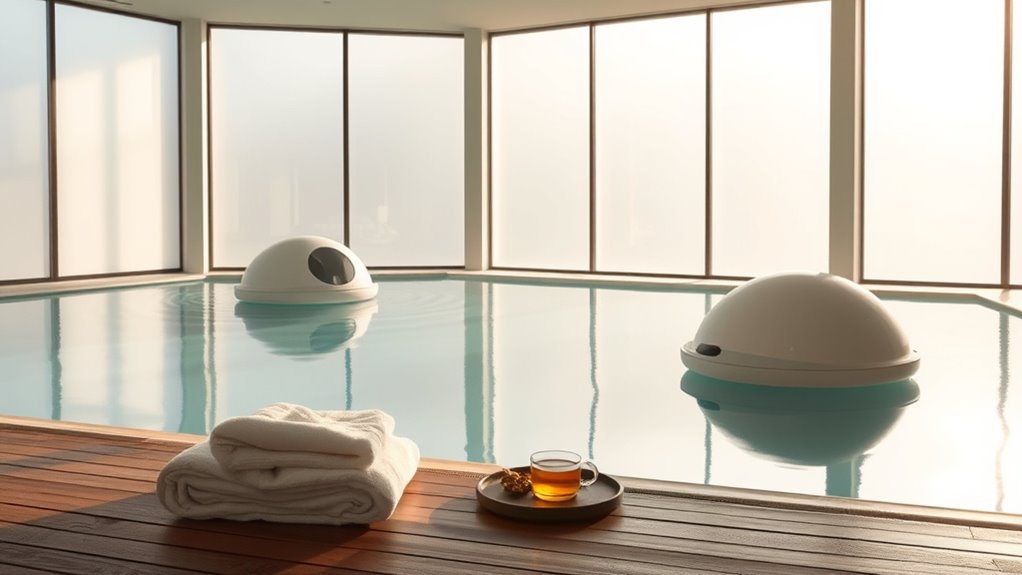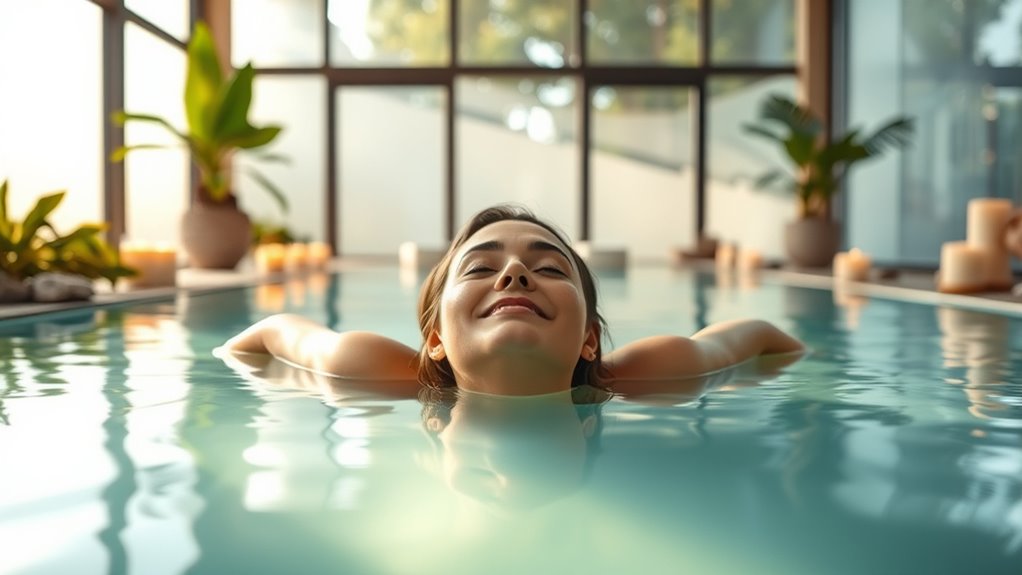To use floating as a relaxation ritual in the morning or afternoon, start by setting a clear intention, like relaxation or mindfulness. Prepare by avoiding stimulants and wearing comfortable earplugs. Enter the float tank during a calm time, trusting the environment’s sensory deprivation to promote mental clarity and emotional balance. Focus on breathing, body scanning, or visualization during your session. Following these steps can help you deepen your relaxation routine—keep exploring to unseal more benefits.
Key Takeaways
- Schedule your float session at a consistent time each morning or afternoon to establish a calming routine.
- Set a clear intention, such as relaxation or mindfulness, before entering the float tank to enhance focus.
- Wear comfortable, translucent earplugs and avoid stimulants like caffeine beforehand to maximize relaxation.
- Use the environment to practice meditation techniques like deep breathing, body scanning, or visualization during the float.
- Incorporate floating into your daily routine to promote stress relief, mental clarity, and emotional balance throughout the day.

Floating therapy has become a popular way to achieve deep relaxation and reduce stress. When you step into a float tank, you enter a space designed to minimize external stimuli, creating an environment of sensory deprivation. This lack of sensory input allows your mind to slow down and enter a state of calm that’s difficult to find in everyday life. To maximize the benefits, you can incorporate meditation techniques into your floating sessions. These techniques help you focus your mind, deepen your relaxation, and enhance your overall experience.
Before you begin, set a clear intention for your float. Decide whether you want to focus on relaxation, mindfulness, or problem-solving. Once you’re in the tank, close your eyes and take slow, deliberate breaths. As the water supports your body, you’ll notice that your usual mental chatter begins to fade. This is the ideal moment to practice meditation techniques, such as body scanning or guided visualization. Body scanning encourages you to mentally observe each part of your body, releasing tension as you go. Guided visualization involves imagining peaceful scenes or affirmations, helping you deepen your sense of calm. Because the environment is designed to eliminate external distractions, your mind can focus more easily on these meditative practices.
Set an intention, relax, and use body scanning or visualization to deepen your calm during floating.
Incorporating sensory deprivation into your routine enhances the effectiveness of your relaxation ritual. The absence of light, sound, and tactile stimuli allows your nervous system to reset, often leading to a feeling of mental clarity and emotional balance. To prepare, avoid caffeine or stimulants beforehand, and wear comfortable, translucent earplugs to block out noise. Once inside the tank, trust the environment to do its work. As you become accustomed to the silence and weightlessness, you might notice your thoughts drifting or your body feeling increasingly relaxed. This state of sensory deprivation can deepen your meditation, making it easier to reach a meditative state faster and more profoundly than traditional sitting meditation. Research also suggests that regular floating sessions can help enhance your mental clarity, supporting overall well-being.
You can tailor your floating sessions to suit your schedule—morning floats can set a peaceful tone for the day, while afternoon floats offer a way to unwind and reset after work. Remember, consistency matters; regular sessions help you develop a deeper connection to your relaxation routine. During each float, focus on your breath, your body, and your intention. Let the environment’s tranquility and the meditation techniques you employ guide you into a state of complete relaxation. With time, floating becomes not just a temporary escape but a powerful tool for managing stress and cultivating mindfulness in your daily life.
Frequently Asked Questions
Can I Float if I Have a Medical Condition?
You should check with your healthcare provider first, as medical restrictions and float contraindications vary. If you have certain conditions like skin infections, open wounds, or severe cardiovascular issues, floating might not be safe. Always disclose your medical history to the float center staff, and follow their advice. Listening to your body is key—if something feels off, stop and seek medical guidance before floating.
How Long Should Each Floating Session Last?
For each floating session, aim for about 60 to 90 minutes to experience maximum relaxation. This duration allows your body to settle into the float and reach a deep state of calm. The ideal timing varies—some prefer morning to start fresh, while others choose afternoon for stress relief. Listen to your body and adjust the session length based on how relaxed you feel, ensuring you don’t overdo it.
Is Prior Experience Necessary to Start Floating?
You don’t need prior experience to start floating; it’s like stepping into a new chapter with an open mind. Float therapy opens the door to meditation benefits, allowing you to find calm and clarity, much like a gentle stream guiding you. With guidance, you’ll quickly discover that floating is accessible and soothing, helping you relax and recharge without needing previous skills or knowledge.
Are There Any Safety Concerns During Floating?
You should be aware of safety concerns during floating, especially regarding water temperature and salt concentration. Make sure the water is comfortably warm, around skin temperature, to avoid overheating or chills. The high salt concentration helps you float easily, but if you’re sensitive or have skin issues, it’s best to consult your provider. Always follow facility guidelines, and inform staff if you feel uncomfortable or have health conditions.
Can Floating Help With Specific Mental Health Issues?
Floating can notably help with specific mental health issues by enhancing mindfulness benefits and reducing stress. When you float, you’ll find it easier to focus on the present moment, which can ease anxiety and depression. This stress relief technique promotes relaxation, lowers cortisol levels, and improves emotional well-being. Regular floating sessions can be a valuable part of your mental health routine, helping you feel calmer, more centered, and better equipped to handle daily challenges.
Conclusion
Embracing floating as your relaxation ritual can transform your mornings or afternoons into moments of pure bliss. As you surrender to the gentle weightlessness, you’ll feel stress melt away faster than snow under the sun. This simple practice can become your sanctuary in a hectic world, offering unparalleled peace and clarity. Make floating a daily habit, and watch your worries dissolve like a mirage—leaving you refreshed, renewed, and ready to conquer anything life throws your way.










